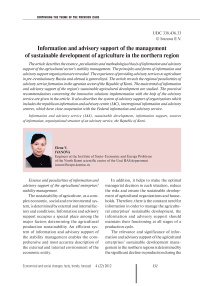Information and advisory support of the management of sustainable development of agriculture in the northern region
Автор: Ivanova Elena Valentinovna
Журнал: Economic and Social Changes: Facts, Trends, Forecast @volnc-esc-en
Рубрика: Continuing the theme of the previous issue
Статья в выпуске: 4 (22) т.5, 2012 года.
Бесплатный доступ
The article describes the essence, peculiarities and methodological basis of information and advisory support of the agricultural sector's stability management. The principles and forms of information and advisory support organization are revealed. The experience of providing advisory services to agriculture in pre-revolutionary Russia and abroad is generalized. The article reveals the regional peculiarities of advisory service formation in the agrarian sector of the Republic of Komi. The main trends of information and advisory support of the region's sustainable agricultural development are studied. The practical recommendations concerning the innovative solutions implementation with the help of the advisory service are given in the article. It also describes the system of advisory support of organizations which includes the republican information and advisory centre (IAC), interregional information and advisory centres, which have close cooperation with the Federal information and advisory service.
Information and advisory service (ias), sustainable development, information support, sources of information, organizational structure of an advisory service, republic of komi
Короткий адрес: https://sciup.org/147223368
IDR: 147223368 | УДК: 338.436.33
Текст научной статьи Information and advisory support of the management of sustainable development of agriculture in the northern region
Essence and peculiarities of information and advisory support of the agricultural enterprises’ stability management.
The sustainability of agriculture, as a complex economic, social and environmental system, is determined by external and internal factors and conditions. Information and advisory support occupies a special place among the major factors determining the agricultural production sustainability. An efficient system of information and advisory support of the stability management enables the comprehensive and most accurate description of the external and internal environment of the economic entity.
In addition, it helps to make the optimal managerial decision in each situation, reduce the risks and ensure the sustainable development of agricultural organizations and households. Therefore, there is the constant need for information in order to manage the agricultural enterprises’ sustainable development, the information and advisory support should maintain their functioning at all stages of a production cycle.
The relevance and significance of information and advisory support of the agricultural enterprises’ sustainable development management in the northern regions is determined by the significant decline in production during the reform periods, resource potential deterioration, increasing outflow of qualified specialists from the village, the sector’s estrangement from innovative development. The efficiency of the sector’s stability management mainly depends on the activity of information and advisory services.
The analysis of scientific literature shows a lot of approaches to revealing the essence of sustainable development. One can agree with the viewpoint of the authors, who define sustainable development of the agricultural sector (enterprise) as the ability to ensure the reproduction of production capabilities, human resources and natural environment in their unity and cooperation over a long period of time. Three closely connected components of sustainable development are distinguished by the authors: economic, social and environmental [6].
Information support is the major factor determining the sustainable development of agricultural production. An efficient system of information support helps to reduce risks in the activities of economic entities and take optimal managerial decisions for each situation. There are different approaches to the notion of information support in the literature. The Economic Encyclopedia gives the most generalized definition of information support, which is regarded as: 1) information, knowledge provided to the consumer in the course of activity aimed at meeting his/her information demands; information which is properly processed (selected, systematized and arran-ged); 2) one of the components of modern automated information systems; 3) process of information provision to individuals or groups in accordance with their information demands [16, p. 248].
Information support includes the following elements: information, information sources, methods of information gathering and analysis, means of collection, issuing, processing, storage and protection of information, information systems and technologies, communication processes.
The basis of information support is the information, which is one of the most important resources, along with material, human and financial.
The information about the technologies and organization of agricultural production and agricultural products processing, means of technological processes’ mechanization and automation, plant varieties and animal breeds, new forms of management organization, market situation, products and material resources serves as an essential part of the agricultural sector’s sustainable development management. The role of information in providing the sustainable development of agriculture increases due to the sector’s transition to the knowledgebased specialization. Modern agricultural production widely uses biotechnology and genetic engineering.
The increased necessity to transfer the information on scientific achievements to agricultural producers is also caused by the fact that, unlike big industrial enterprises, the agricultural organizations and peasant (farmer) households, due to a lack of financial resources, can’t carry out scientific research and independently organize the scientific-technical maintenance of agricultural activities. Besides, over the years of market transformations, the number of highly qualified specialists in agricultural organizations decreased significantly. In the pre-reform period, specialists at big agricultural enterprises practically fulfilled the consulting function as they possessed the knowledge concerning innovations.
Educational institutions, scientific organizations, subjects of the agricultural and food market, legislative and executive bodies are the main sources of information for different types of sustainability. Higher and secondary special educational institutions, institutes of retraining and advanced training of the agroindustrial complex (AIC) employees develop educational-methodological, scientific-methodical materials.
Scientific-research organizations provide scientific works, scientific-methodical materials, information about the research and development to be used in production activities. Indicators of agricultural organizations and farms, market conditions are the source of information provided by the production and market sphere. The information provided by the state authorities consists of normative-legal acts, analytical and current information.
In the course of their activities, agricultural producers receive important information from the regional ministries (departments) of agriculture, municipal agricultural administrations, information and advisory services, individual advisers. The information can be also obtained from TV, periodicals, Internet, scientific-practical seminars and conferences, specialized exhibitions and presentations.
Agricultural enterprises use different types of information: scientific-technical, industrial, managerial, economic, social, legal. Depending on the sources of its obtaining, information is divided into internal and external. Internal information includes all kinds of accounting, book-keeping and statistical reports, contractual relations with suppliers, buyers and investors, different kinds of plans, business plans, etc.
The information obtained outside an agricultural enterprise is external. It includes the information concerning taxation, crediting, pricing, the situation with demand for and supply of foodstuffs; interest rates for loans; activities of the buyers of agricultural products and suppliers of various industrial production resources, information concerning the provision of repair and construction services; new technologies, plant varieties and animal breeds; forms of production and management organization; advisory information on legislative, legal and financial issues; on the organization of accounting and reporting, etc. The use of various information sources, its processing and storage allow making decisions concerning the sustainable development of agricultural enterprises.
There is a wide range of means and methods of information transmission from its source to its user. The spread of knowledge and information transfer to the agricultural producers faced many stages of development, from oral lecture-advisory service, initial publishing activity to modern computerized communication system.
The essence of information and advisory service lies in its ability to extract from the system of the existing knowledge and information funds the information which is a combination of these information sources [10, p. 16].
The role of information and advisory services consists in transmitting scientific, technological and market information, advanced domestic and foreign production experience to the users.
The main representatives of this service are consulting specialists, well acquainted with legislation and agricultural production, marketbased management methods, having the skills of management decisions drafting, communication and teaching skills. Users of information and advisory services are represented by agricultural and agroindustrial organizations, peasant (farm) households, state management authorities of the agroindustrial complex, population. Each subject is interested to receive economic, social and environmental effect from the rendered services.
The agricultural advisory service has quite a few definitions. According to John Russell, it can be defined as the provision of knowledge and skills that farmers need in order to acquire and implement more efficient methods in crop and livestock production for the purpose of increasing productivity and improving living standards.
K.M. Fisher and others give approximately the same definition of the service. In their interpretation, the agricultural advisory and farmers training service has as its goal the transfer of information and practical skills for more effective use of available resources.
Figure 1. The basic directions of information and advisory service activities
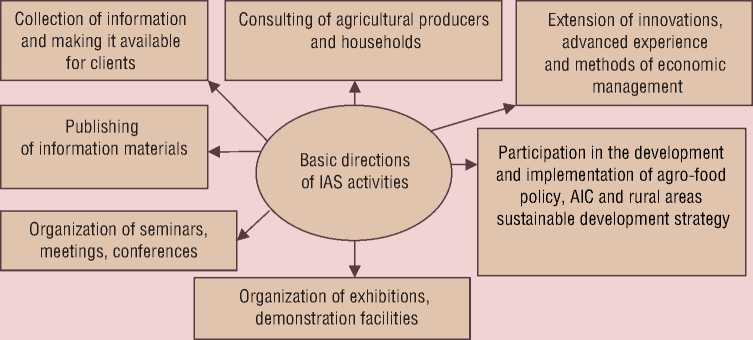
However, the essence of the service is expressed most clearly by A.W. Van Den Ban and H.S. Hawkins: “The agricultural advisory service is a purposeful transmission of information in order to help people form a sound opinion and make right decisions” [op. cit.: 3, p. 7].
The agricultural advisory service not only organizes the transfer of ideas, information, knowledge, advice, skills, but also provides practical assistance for their implementation in production. The information and advisory service is the link between science, education and production sphere. The basic directions of the service activities include: information, consulting, innovation, education, exhibition, publishing activities, as well as participation in the agricultural policy development and implementation (fig. 1) .
An important role in advisory service belongs to consultants, the activities of which are aimed at transferring new knowledge to agricultural producers. However, as A. Chaya-nov points out, the employee of the public agriculture (consultant) “is a figure more social rather than technical. The objects of his/her activity are people, their minds, their will and consciousness, and not only the field, livestock and agricultural equipment” [14].
At present, the AIC information and advisory support system includes Federal, regional and district (inter-district) levels (fig. 2) .
In the Republic of Komi the information and advisory center was established at the regional level at the Institute of retraining and advanced training of AIC employees and represents its structural subdivision consisting of two people. The staff of the center combines consulting activity with teaching. At the district (inter-district) level IAS is absent.
Today, the IAS organizational structure is focused mainly on providing services free of charge. The questionnaire survey data showed that only 6% of the country’s agricultural producers are willing to pay for the rendered services (creating business-plans and constitutive documents). Considerable amount of funding is allocated for the provision of advisory support to agricultural producers and retraining of specialists for agriculture within the framework of the State program of agricultural development and regulation of agricultural products, raw materials and food markets for the period of 2008 – 2012.
Thus, the information and advisory service is a single state multilevel system that actively cooperates with science, education and agroindustrial sphere in order to provide agricultural entities and governing bodies with information for its practical application. Financially, the service is mainly state-supported.
Figure 2. Organizational structure of the information and advisory service of the RF agroindustrial complex
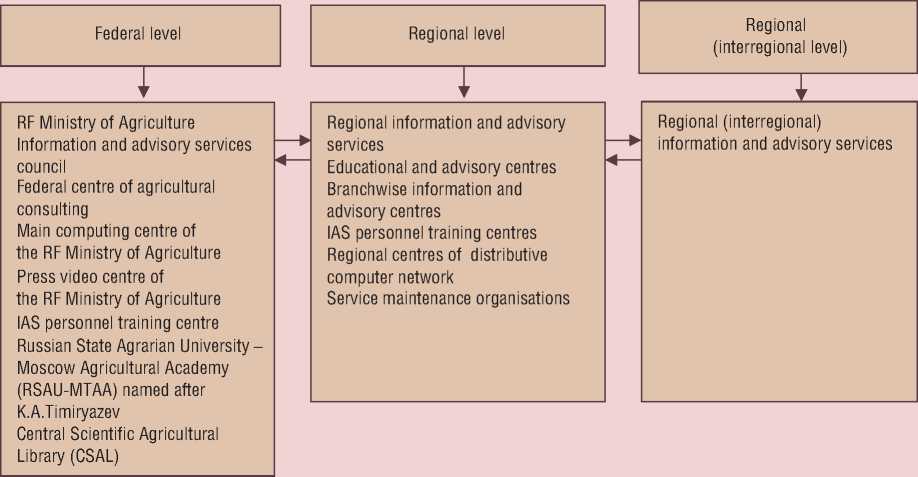
The experience of providing advisory services to agriculture in pre-revolutionary Russia and abroad
Russia is one of the first countries, where agricultural consulting emerged. V.M. Bautin and V.V. Lazovsky, the prominent scientists in the sphere of information and advisory support of agrarian sector, believe that the overview-analytical report of the Dutch scientist A.W. Van Den Ban, which he presented in 1998 at the IAS conference, is the best work covering the history of information and advisory service development in pre-revolutionary Russia [19].
The first agricultural society in Russia was established in 1765; it laid the foundation “for the first special institution of agronomists for giving consultations in different provinces”. In 1797, under the jurisdiction of the Senate, the Government Expedition was established, and, attached to it – the “Practical school of agriculture”. School graduates were sent to remote villages, where they were given the land for establishing instructional farms and teaching advanced farming practices to local peasants.
The Committee on improvement of agriculture in Russia was established In 1833, and the Finance Ministry initiated the establishment of the “Institute of practical agronomists” in 1834. The ultimate goal of the agronomists’ activities was the development of agricultural consciousness in different population groups and competitive spirit between farmers, for that purpose exhibitions and contests with distribution of prizes and awards were organized. In 1886, zemstvos, the first Russian public organizations, the goals of which included, in particular, the solution of agricultural problems at the local level, were established.
Since 1906 the formation of the district agronomy began, the essence of which was to provide agricultural and economic support to the population. The district agronomist was in the service of the zemstvo, i.e. represented a public agroeconomic organization, the financing of which was carried out at the expense of the members. Since 1908, the government began to provide constant support to the district agronomy, and by 1911 there were more than 3600 district agronomists in Russia.
According to the functions, tasks and servicing areas a pre-revolutionary district agronomist corresponded to the modern field consultant, who is considered the main figure in the system of information and advisory service in developed countries.
During the second agrarian reform, there appeared a new representative of agronomic service: the khutor agronomist [Russian: хуторный агроном, khutor – a singlehomestead rural settlement of Eastern Europe – translator’s note]. There were more than 1580 khutor agronomists in 1911 in Russia. Their main task was to assist individual farmers. Over time, they were allowed to provide assistance to community members. A khutor agronomist was a government official and received financial support from the government.
Nine thousand employees worked in the Russian system of agricultural consulting in 1913. A.W. Van Den Ban notes that at the time the Russian agricultural advisory service was, perhaps, the best in the world [19].
The first theoretical research and further development of the agricultural advisory service, especially in 1916 – 1924, is connected with the name of an outstanding Russian scientist-agronomist A.V. Chayanov.
He believed that “no system, no public scope, even possessing all the power of a state organization, is capable of implementing with greater success the organizational reform of agriculture. It is necessary to use the interest of private commodity producers, national economic forces. Public agronomy (consulting) should act as a catalyst stimulating and guiding the work of agricultural producers.”[5]. The ideas of A.V. Chayanov, who is the founder of scientific approaches to agricultural consulting, are widely used all over the world.
Unfortunately, the development of this sphere of activities was interrupted in our country for many years. The Ministry of Agriculture and Food of the Russian Federation began to restore the information and advisory service only in 1993.
The first state advisory services emerged in the late 19 – early 20 century in Holland and the USA. The American model is of particular interest to the creators of Russian IAS. In the U.S. the agricultural knowledge dissemination service, known as the Cooperative Extension Service, was established in 1862, when the law on the organization of science, agricultural education and knowledge dissemination among farmers was passed. According to the law, the functions were entrusted to 74 land-grant universities (agricultural institutions of higher education of the states that were granted land from the government free of charge in order to fulfill this task). At the federal level the Cooperative Extension Service was set up in 1914, with the passing of the Smith-Lever Act.
At present, the U.S. Cooperative Extension Service represents the state cooperative service of knowledge dissemination, which comprises the U.S. Department of Agriculture (Federal level) and united systems of the states comprising the extension services of universities and districts. In general, the extension service of the states involves 74 public universities, 130 agricultural colleges, 27 colleges of veterinary medicine, 59 experiment stations, 63 schools of forestry and 3150 extension service offices in administrative districts (counties).
At the Federal level, the Cooperative Extension Service is a part of the U.S. Ministry of Agriculture and represents an Administration with a staff about 200 employees. The Federal service coordinates the activities of all the country’s extension service partners, covering a wide range of industrial and social problems: agricultural production, development of the rural economy, development of a farm family, the natural resources and environmental management.
At the level of the states, the extension service is an integrated system, which includes extension services of the universities and districts.
Each County has its own extension service with staff number ranging from 3 up to 15 people. District services are subordinated to the services of the states. For the specialists of the district services briefings are regularly held at the university. Possessing a Master’s or a higher degree is the obligatory requirement for specialists [3].
The summary of international experience in agricultural information and advisory services, which is represented most fully in the domestic and foreign publications [1, 2, 3, 4, 7, 8, 9, 10, 12, 13, 14, 17, 18], indicates that services of agricultural consulting operate for many decades, and play a prominent part in the improvement of technologies, farmer production organization and management.
In the world practice, the goods producers’ advisory services can be organized according to various models: advisory services under the ministries of agriculture and food (Great Britain, Germany, the Netherlands, Poland); the university model (most widespread in the United States); information and advisory services, created on the basis of leading agricultural colleges (Scotland, in some states (Länder or federal states) of Germany); information and advisory services, created on the basis of farmer organizations (Finland); private advisory services, functioning at the present time, in many agriculturally developed countries (England, Wales, New Zealand, etc.).
Despite the variety of organizational forms, advisory services have common features, which are expressed in the following:
-
• the services were established in most countries according to the decision of state bodies and for a long time they were funded through the budget, while the gradual transition from full government financing to partial compensation for the rendered services through charging fees to clients began along with gaining credibility and sustainable development of agriculture;
-
• advisory services are established at the national, regional and local levels, in their close interaction;
-
• scientific and educational institutions staff, mass media are engaged in the activities of the services.
For Russia and its regions it is impossible to copy the foreign models of information and advisory services due to the peculiarities of its agricultural sector development, mixed character of agrarian economy, little state support of agricultural producers, historically formed mentality of the peasants, expressed in their inclination to collective work.
Regional peculiarities of information and advisory service formation
Establishing a regional information and advisory service is connected with the peculiarities of agroindustrial complex development. The agro-food sector of the Republic of Komi does not occupy a dominant position in the economy. Now it accounts for 2.6% of the gross regional product and 0.8% of investments in fixed capital, 2.8% of the average annual number of the employed in the economy.
The industrial character of the Republic’s development determined the prevalence of urban population. Its share in the total number of population equals 77%. At the beginning of 2011, it was 899.7 thousand people, of which 693.2 thousand lived in cities and 206.5 thousand – in rural areas.
One of the agricultural production peculiarities is its great dependence on natural and economic conditions. The Republic of Komi occupies 2.4% of Russian territory. The share of the most productive land –ploughland – equals only 0.2% of the area, while in the country in general, this indicator equals 7.1%. The share of plowed land reaches 25% against 55% for the country in average. The poor development of the Republic’s territory is explained by the natural conditions unfavorable for agriculture, vast forest areas (74.6%), and small density of population.
The largest share of agricultural land (83%) is used by collective organizations. 15% of the total area is at the disposal of private households, in average, one family possesses 0.4 ha. Total area of the land plots provided to farms is 7.7 thousand ha (2% of agricultural land) or, in average, 28 ha per one farm.
Due to the unfavourable natural and economic conditions of agricultural development in the Republic of Komi, its food self-sufficiency is low. At present, self-sufficiency for meat and meat products equals 27%, milk and milk products – 27%, egg and egg products – 72%, potato – 75%, vegetables – 24%. However, the region has favorable conditions for producing socially important products. Agronatural (sufficient amount of precipitations, long light day in the vegetation period, large areas of natural forage lands, including floodplain meadows) and economic potentials contribute to the efficient potato growing, cattle, reindeer and poultry breeding. The Republic possesses the resources for producing organic products and forming the respective market segment. A kind of rental income can be received from the realization of environmentally safe products. Products of traditional economic sectors (reindeer breeding, fishing, hunting, mushrooming and berrying) are competitive not only at the regional but also national and international markets.
Creating the regional information and advisory service is closely connected with organizational and legal forms of management, staffing with managerial personnel, general trade specialists, and their professional level.
The food sector of the Republic is represented by diversified agricultural organizations, manufacturers of food production, farms and private subsidiary plots of citizens. In 2010, 190 agricultural organisations and institutions’ subsidiary plots, more than 93 thousand private subsidiary plots, 437 peasant (farmer) households, 76 thousand gardening families and 30 thousand vegetable growing families were involved in agricultural production.
In the total volume of gross agricultural production, agricultural enterprises account for 55%, private households – 41%, peasant (farmer) households – 4%. Agricultural organizations are leaders in livestock production output (fig. 3) .
For the years of agrarian reform there has been a significant decrease in the concentration of production and downsizing of agricultural organizations. While in 1990s there were in average 428 workers per one agricultural enterprise, 4 thousand ha of agricultural land, 1021 ha of crops, 1694 head of livestock including 661 cows, 65 tractors, at present these figures equal respectively: 99 workers; 1.1 thousand ha; 376 ha; 307 head including 133 cows; 14 tractors.
Transition to market economy had a negative impact on the agrarian sector. During 1990 – 2010 milk production decreased 3.4-fold, livestock meat production (in slaughter weight) – 3.1-fold. For this period, given the population reduction by more than 1/3, meat production per capita for a year has decreased from 31 to 19 kg, milk – from 166 to 68 kg, eggs – from 294 to 186 pieces.
For the years of reforms, the sector has experienced the production capabilities reduction and to a certain extent lost its industrial character. Areas of cultivated agricultural land, for the period under review, decreased from 353 thousand to 191 thousand ha, areas under crops – from 100.5 thousand to 40.5 thousand ha; livestock population decreased from 173.5 thousand to 38.7 thousand head, reindeer – from 123.6 thousand to 83.8 thousand head. The number of employees at agricultural organizations decreased more than 3-fold.
In the creation of an information and advisory service, great importance is attached to the availability of scientific and education potential capable of interacting with an advisory service, as well as the degree of innovative activities implementation in the agroindustrial complex.
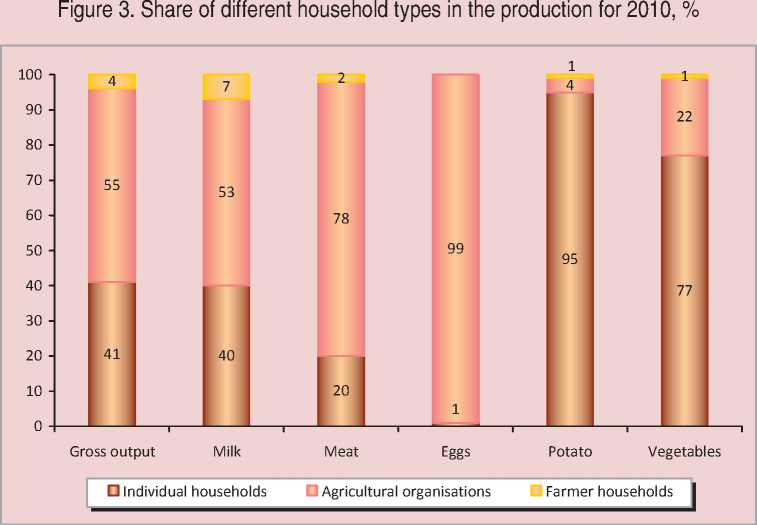
The cooperation between the information and advisory service specialists, scientists and educators can be directed towards the use of new high-yielding plant varieties, highly effective fertilizers, produced from industrial wood residue and local agronomical ore; biological nitrogen; sapropel; innovative technologies in dairy and beef livestock husbandry and reindeer breeding, as well as the elaboration of agricultural sector and rural areas sustainable development concepts and programs at the regional and municipal levels. The Republic’s higher education institutions should provide the up-to-date training of consulting specialists which will allow solving practical tasks of the agrarian sector’s innovative development.
The pattern of possible cooperation between IAS and agrarian sector’s governing and supporting bodies, scientific, educational and information establishments within the Republic of Komi is presented in figure 4 .
Thus, the formation and development of the regional information and advisory service requires taking into account the factors and conditions of agricultural sector’s functioning which is connected with natural conditions, socio-economic factors, agroindustrial production management and support, farmers’ mentality, AIC staffing with personnel and scientific-educational resources, agricultural enterprises’ innovative activity. The regional agricultural advisory service which is closely connected with the bodies of AIC governing and support, scientific and educational establishments, advanced development organizations facilitates the transfer of scientific, technological and market information, advanced domestic and foreign experience as well as provides practical assistance in innovations implementation in production.
Conceptual approaches to establishing the regional information and advisory service
Today, the information and advisory support of agricultural producers in the Republic of Komi is at the early stage of its development. The issues concerning the status of IAS, its formation at the district level and its financing remain unsolved. Due to the lack of financial resources, the information and advisory centre doesn’t carry out advertising and publishing activities, issuing of information materials, newsletters, surveys; the agricultural producers’ demand for information about production, storage, processing and realization of products is not satisfied properly; the system of information and advisory support for rural population is developing rather slowly; it is difficult for information and advisory service establishments to attract highly qualified specialists, having practical work experience. Dissatisfied with the amount of wages, regular employees have to combine their main work with teaching. This results in the reduction of the quality and volume of rendered services.
Figure 4. Interaction of the regional information and advisory service with the bodies of agroindustrial complex governing and support, scientific, educational and information establishments in innovations implementation
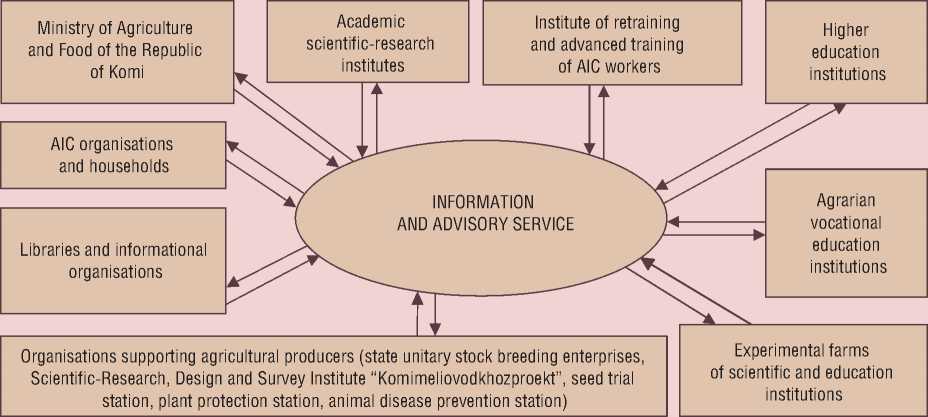
Analysis proves that the state of affairs concerning the information and advisory service organization in other regions of the Russian European North is quite the same. For instance, the main factors, hampering the agricultural organisations’ information and advisory support system development in the Vologda Oblast, are the following: understaffing of an advisory service with specialists; absence of agricultural producers’ development monitoring; poor material and technical provision of the service; lack of clear distribution of functions in an information and advisory centre; underdevelopment of organization structures; lack of funding sources for advisory services payment [11, p.13].
Agricultural producers as well as regional AIC governing bodies are interested in the efficient functioning of an integrated information and advisory service. This interest is connected with the implementation by IAS of agro-food policy, strategy of sustainable agricultural and rural development through innovations extension and implementation, advanced experience and economic management methods, market information. Regional authorities and governing bodies provide financial support to agricultural producers. In average, for 2008 – 2010 the share of state budget of the Republic of Komi allocated to the agricultural sector support equaled 89 %, and federal – only 11 %.
While forming and developing IAS in the Republic of Komi, it is necessary to take into account natural, socio-economic factors and institutional peculiarities of agricultural production. The information and advisory service in the form of non-commercial organization based on scientific and educational institutions, using their material and human resources, is the most perspective for the republic. The requirement for republican information and advisory centre’s services will be fulfilled by agricultural organisations and households of suburban districts and municipalities of the cities.
It is inexpedient to establish IAS in every remote rural district. It is the interregional information and advisory service that needs to be created. The proposed system of information and advisory support of collective organisations, peasant (farmer) households and private households is shown in figure 5 .
Nowadays, the majority of agricultural organisations and farmer households in the Republic of Komi have lost their economic and social stability. Therefore, the agrarian production modernization with the use of innovative technologies plays a special role in ensuring this stability. International practice shows that about 60 – 80% of agricultural producers are capable of developing innovations with the help of an agricultural advisory service. Thus, the regional IAS activity should be directed towards the large-scale extension of R&D and advanced experience. It can be achieved by creating the data base of innovative R&D; methodological, information and advisory support of AIC organisations concerning the innovative technologies implementation; support in assessing the innovative projects efficiency.
It is advisable to establish a scientific-coordination council under the Republic’s Ministry of Agriculture and Food in order to choose the most efficient directions of innovative activity. It will comprise the representatives of IAS, scientific and educational organisations, sector associations of agricultural producers, specialists and heads of agroindustrial enterprises, regional and municipal governing bodies. The main goals of the council include: determining the strategy and tactics of the regional AIC innovative development and innovative strategy implementation monitoring. An independent expert commission should be created to estimate the innovative strategy implementation.
Given the difficult situation in the agricultural sector, it is inappropriate to orient towards the overall commercialization of advisory activity.
Figure 5. Structure of information and advisory support of agricultural sector in the Republic of Komi
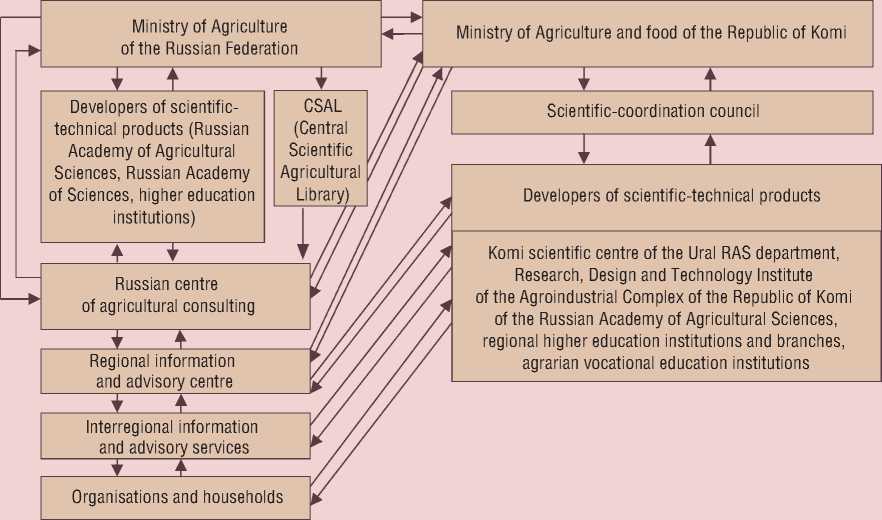
The IAS funding should be effected mainly at the expense of the budget. World practice shows that advisory organisations provide their services free of charge at early stages of their development. After gaining authority and only under conditions of sustainable agricultural development, the information and advisory organisations gradually switched over to the provision of paid services. The transition takes quite a long time. For example, the Netherlands and Denmark required 120 years just to shape this problem, and in Britain advisory services were able to proceed to partial self-financing only after 50 years of work [5, p.15]. Introduction of benefits on paid services for individuals is expedient when the IAS formation process is finished and its development goes on.
In conclusion it is necessary to state the following:
-
• an efficient agricultural information and advisory support system enables to study an external and internal environment most
comprehensively and accurately, reduce risks in the activities of economic entities and provide their sustainable development;
-
• study of domestic and foreign experience in creating and functioning of agricultural information and advisory support proves: the services were established according to the decision of the state authorities at the national, regional and local levels in their close cooperation; for a long time, the services rendered by information and advisory organisations were financed from the budget with gradual transition to paid services; the peculiarities of the domestic agrarian sector don’t allow to copy foreign models of information and advisory services;
-
• analysis of the ways, in which the information and advisory support is organized, indicates that the main factors hampering the agricultural organisations’ information and advisory support system development in the Republic of Komi are the following: understaffing of the service with specialists; lack of funding sources for advisory services
payment; insufficient interaction between the information and advisory centre and the regional AIC governing and managing bodies, scientific, educational and information establishments; absence of information and advisory services at the municipal level;
-
• proposed system of information and advisory support of the republic’s agrarian sector comprises regional and interregional levels in their close cooperation with scientific and educational institutions, governing bodies and information establishments.
Список литературы Information and advisory support of the management of sustainable development of agriculture in the northern region
- Bautin V.M., Lazovskiy V.V. Information and advisory service of the Russian agroindustrial complex. Moscow: Kolos, 1996.
- Belitskaya O.L. Danish model of farmers' organizational advisory service. Information Bulletin of the Ministry of Agriculture of the Russian Federation. 1999. No. 9 -10. P. 46 -51.
- Veselovskiy M.Ya. Information and advisory service of the Russian agroindustrial sector (Theoretical and practical issues). Moscow: FSSI “Rosinformagrotech”, 2002.
- Veselovskiy M.Ya., Klimenko Yu.I. Organization of agricultural consulting in Finland. Information Bulletin of the Ministry of Agriculture of the Russian Federation. 2001. No. 8. P. 43 -46.
- Demishkevich G. State support and mechanism of formation of a territorial network of agricultural advisory centres. International agriculture journal. 2009. No. 5. P. 14 -16.
- Ivanov V.A., Ponomareva A.S. Methodological bases of the agrarian sector's sustainable development. Economic and social changes: facts, trends, forecast. 2011. No. 4 (16). P. 109 -121.
- Makovetskiy V.V. Agricultural extension service in the USA. Information Bulletin of the Ministry of Agriculture and Food of Russia. 1997. No. 7 -8. P. 51 -53.
- Makovetskiy V.V. Agricultural advisory services in England, Wales Information Bulletin of the Ministry of Agriculture and Food of Russia. 1998. No. 5 -6. P. 51 -54.
- Mikhailenko I.M. Information and advisory support of the agroindustrial complex. Moscow: FSSI “Rosinformagrotech”, 2000.
- Mikhailenko I.M. Agricultural advisory system in Poland. Information Bulletin of the Ministry of Agriculture and Food of Russia. 1998. No. 33 -4. P. 55 -60.
- Mikhailovskaya A.L. Organization of management consulting in the agroindustrial complex of the region: Abstract of the Ph.D. thesis. Vologda, 2006.
- Nazarenko V.I. Information, information technology and advisory service in agriculture. Moscow: AMB-agro LLP “Dis-Art”, 1998.
- Runov B.A. Extension service: why it is useful for Russia!. Agrarian Russia. 1997. 312. P. 31 -32.
- Filatov F.I. The system of advisory services in the agriculture of Germany. Information Bulletin of the Ministry of Agriculture and Food of Russia. 1997. No. 7 -8. P. 49 -51.
- Chayanov A.V. The basic ideas and methods of work of the Public Agronomy. 3rd ed., revised and added. Moscow: Narkomzem publishing house “New village”, 1924.
- Economic encyclopedia. Chief ed. L.I. Abalkin. Moscow: OJSC “Publishing house “Economics”, 1999.
- Corten I.M. Net Kennis. En informative systeem van de Nederlandse bosbouwsector Nederl. Bosb. Tijdschr. 1992. Jg. 64, P. 4.
- Rasmussen W. D. Yaking the university to the people, Seventy five years of cooperative extension. Ames (Iowa); Iowa state univ. Press, 1989.
- Van Den Ban A.W. Forms and methods of work of information-consulting service in Russia: Sd card. Mater. Konf. po IKS. M., 1998.

